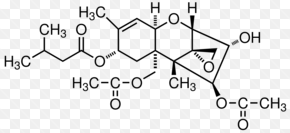ToxicBlackMould
Information about mould and mould disease
T-2 toxin

T-2 toxin is one of the most toxic trichothecenes toxins that could be under certain circumstances detected in the indoor environment. Its toxicity has lead to its use as a biological weapon by militaries across the globe. Exposure to high doses of T-2 toxincauses headache, dizziness, vertigo, fatigue, tachycardia, salivation and fever. Contact with skin caused local blistering and necrosis followed by bacterial infections.
It is very unlikely that people could be exposed to high enough concentrations of this toxin in normal domestic situation but exposure to low concentration of this toxin over long periods of time could results in slow poisoning and adverse health effects.
T-2 and other trichothecene toxins are deacetylated in the liver but their metabolites are also toxic but less so. The most potent T-2 toxin but also other related trichothecenes are absorbed relatively slowly (12 to 24 hours) through the undamaged skin but the absorption is much more rapid through damaged skin.
It is suspected that T-2 toxin is associated with a human disease called alimentary toxic aleukia which manifest itself by inflammation of the skin, vomiting, and damage to hematopoietic tissues. The acute phase is accompanied by necrosis in the oral cavity, bleeding from the nose, mouth, vagina, and central nervous system disorders.
Deoxynivalenol (Vomitotoxin) (DON)

It is the least toxic tricothecene also known as T-4 or commonly found in grains. This toxin causes vomiting, nausea and diarrhoea when ingested by agricultural stock in high doses. Ingestion at lower doses mainly by pigs and also other animals manifest itself by food refusal and consequently weight loss. Because of this response, deoxynivalenol is sometimes referred to as the food refusal factor or "vomitoxin". Deoxynivalenol is commonly found in agricultural feed such as wheat, corn, barley rye and other mixed foods but fortunately is not as toxic as other mycotoxins belonging to this group.
Deoxynivalenol has an immunosuppressive effect that results in decreased resistance to infectious microbes. They then consequently cause a wide range of neurological, dermatological and gastrointestinal symptoms.
Satratoxin H

It is a naturally occurring mould toxin produced by Black Toxic Mould (Stachybotrys Chartarum). This toxin is harmful to both animals and humans and exposure to this toxin causes disease Stachybotrotoxicosis. Satratoxin-H is almost completely insoluble in water, but is easily soluble in lower alcohols and polar solvents such as ethanol, methanol, isopropanol acetone and chloroform. Satratoxin-H is extremely versatile. Contact with this toxin inhalation, physical contact or ingestion results in adverse symptoms similar to the ones listed below.
- moist dermatitis and rash
- chest pain
- nose bleeds
- pulmonary haemorrhage (bleeding in the lungs)
- fatigue
- headache
- hyperthermia (raised temperature)
However, exposure to large quantities of this toxin can be often lethal. The effects of Satratoxin-H on bare skin are negligible, the skin typically does not blister however contact with moist and sensitive surfaces ( interior of mouth, nose or eyes) it can rash and serious skin irritation.
Stachybotryotoxicosiswas described by agricultural workers at the beginning of the century as a peculiar disease with high mortality rates linked with mouldy hay and straw. Until recently, human stachybotryotoxicosis was considered a rare occupational disease limited largely to farm workers who handle mouldy hay. Stachybotrys grows very well on water saturated building materials( wall paper, plasterboard) with relatively high cellulose content (paper). The most frequently colonise materials include water-damaged gypsum board, wood fibber boards, ceiling tiles and moist air conditioning ducts. The presence of Stachybotrys has been associated with pulmonary bleeding in infants.
Zearalenone

Zearalenone is a secondary trichothecenes metabolite from Fusarium graminearum, Fusarium culmorum, Fusarium equiseti and Fusarium crookwellense. All these fusarium moulds are frequent contaminants of cereal crops across the world. It cannot be considered to be truly toxic to humans because it behaves much like a hormone. Exposure to high levels of zearalenone, mainly through consumption of food is associated with hyperestrogenism – strong feminization of the victim (uterine prolapse in girls and testicular atrophy and enhanced mammary development in boys).
Diacetoxyscirpenol (DAS)
.png)
Also known as anguidine, this is a less toxic type of tricothecene known as T-3 and produced by Fusarium. It is a very important toxins because thanks to his chemical structure it has the ability to interact with other mycotoxins and make them much more potent.
